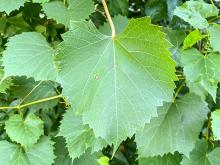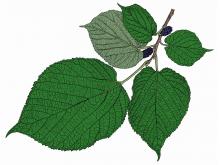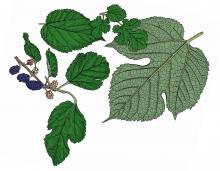Trees, Shrubs and Woody Vines
Media

Species Types
Scientific Name
Vitis species
Description
Eight species of grapes in the genus Vitis are native or naturalized in Missouri. All bear edible fruits. Like their relatives elsewhere, they have important connections to humans and to nature.
Media

Species Types
Scientific Name
Quercus spp.
Description
Oaks are the most important group of trees in Missouri, in both human and ecosystem value. They dominate most of the forests, woodlands, and savannas in the state. Learn more about our 22 species.
Media

Species Types
Scientific Name
Quercus lyrata
Description
Overcup oak is fairly easy to identify. The acorns are almost completely covered by their knobby cups. The leaves have long, narrow lobes and wide sinuses. In Missouri, it grows naturally only in wet forests along the Mississippi and Meramec rivers.
Media

Species Types
Scientific Name
Sassafras albidum
Description
Sassafras, with its aromatic oval, mitten- , and trident-shaped leaves, is rich in both human and natural history, and it can be a spectacular tree for fall color.
Media

Species Types
Scientific Name
Various species in the genus Crataegus
Description
Our state flower, the hawthorn, is solidly represented in Missouri. There are about 100 different kinds of hawthorns that occupy almost every kind of soil in every part of the state. These members of the rose family are closely related to apples.
Media

Species Types
Scientific Name
Malus ioensis
Description
Prairie crab apple is an attractive, small, ornamental tree with low, crooked branches and attractive spring flowers. Its hard, bitter fruits can be used in making tasty jellies, cider, and vinegar.
Media

Species Types
Scientific Name
Morus rubra
Description
Red mulberry is native to Missouri and North America. You can distinguish it from the introduced white mulberry tree, which is a noxious weed, by its leaves and fruits.
Media

Species Types
Scientific Name
Morus alba
Description
White mulberry was introduced from Asia for its berries and as fodder for an attempted silkworm industry. Birds have helped spread white mulberry so much that in many places it is more common than our native red mulberry.
Media

Species Types
Scientific Name
Platanus occidentalis
Description
The white, smooth-looking limbs of sycamore rise over countless streams and river banks, as well as over sidewalks and city streets. The leaves, which somewhat resemble those of maples, can reach remarkably large sizes.
Media

Species Types
Scientific Name
Acer rubrum
Description
Red maple is one of our most useful — and beautiful — native trees. You can find it in the woods as well as in landscape plantings statewide. Many horticultural varieties are available at nurseries.
See Also
About Trees, Shrubs and Woody Vines in Missouri
There are no sharp dividing lines between trees, shrubs, and woody vines, or even between woody and nonwoody plants. “Wood” is a type of tissue made of cellulose and lignin that many plants develop as they mature — whether they are “woody” or not. Trees are woody plants over 13 feet tall with a single trunk. Shrubs are less than 13 feet tall, with multiple stems. Vines require support or else sprawl over the ground.





















